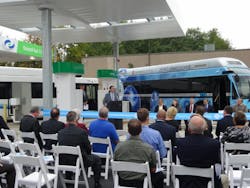Refueling Station Ribbon Cutting Moves SARTA's Hydrogen Fuel Cell Program Closer to Completion
SARTA's drive to launch the largest fleet of Hydrogen Fuel Cell-Powered (FC) buses outside of California have moved one step closer to completion as federal, state and local officials, public transit advocates and community leaders participated in the ribbon cutting ceremony marking the opening of the authority's State-Of-The-Art Hydrogen Refueling Station. The facility, which was constructed at SARTA's headquarters on Gateway Boulevard in Canton, will service the ten HFC vehicles that will be in regular service on SARTA's routes by the end of 2018. Those attending the ribbon cutting had the opportunity to inspect one of the buses and tour the filling station after the ceremony.
Kirt Conrad, SARTA's CEO; Tomas Bernabei, Mayor of Canton; Frank LaRose, State of Ohio Senator; Dave Farese, Air Products' Hydrogen Energy Systems engineering manager; Pat Valente, Ohio Fuel Cell Coalition (OFFC) executive director; Dr. Jim Durand, Ohio State University's Center for Automotive research director of testing & engineering services; and Dr. Nancy Garland, of the U.S. Department of Energy's Office of Energy Efficiencies & Renewable Energy offered remarks during the ceremony.
Conrad explained that the hydrogen fueling station operates much like the system used to refuel SARTA's fleet of Compressed Natural Gas-Powered (CNG) vehicles. The hydrogen system consists of a tank that store's the pressurized hydrogen after it is delivered by a tanker truck, a high-pressure buffer storage system which delivers gaseous hydrogen to the vehicle tank, a compressor that pressurizes hydrogen from the storage source to the pressurized buffer storage tank, a refrigeration system that pre-cools the hydrogen gas being dispensed into the vehicle's tank and a dispenser that manages the flow of hydrogen to the vehicle's tank. The hydrogen is then converted to electricity using a Proton Exchange Membrane (PEM) fuel cell onboard the bus. Both the $1.6 million facility and the FC buses feature tested and approved safety controls and equipment.
Conrad emphasized that the entire cost of the fuel cell research and development program, including the construction of the fueling station and the purchase of ten buses, is being funded entirely by $20 million in state and federal grants. "Our success in obtaining funding from outside sources has enabled us to both become a national leader in transit research and technology and get the most mileage possible from the dollars we receive from our sales tax and other local sources," Conrad said. "That's why we've been able to add routes and state-of-the-art rider tools like Pin-Point, Google Transit and GoLine without raising fares or seeking a tax increase."
SARTA decided to actively participate in the hydrogen fuel cell "revolution" for a number of reasons. "First, our involvement will enable us to cut our fuel costs by as much as fifty percent in the years ahead and second to maintain our position as trailblazers in the use of green technology to fuel public transit. Additionally, this project will drive investment, research, business development and job creation here in Stark County and across our state," he said. "Honda, Worthington Industries, LG Fuel Cell Systems, Swagelok and other Ohio companies as well as universities including Stark State, the Ohio State University and Case Western Reserve are heavily involved and invested in fuel cell-related manufacturing and R and D projects."
"We want to be at the forefront of commercializing this technology because transit systems, businesses and private citizens will begin to utilize fuel cell-powered vehicles featuring components and technology developed and manufactured in Stark County. Hydrogen is a practical, safe, cost-effective and environmentally friendly alternative to traditional fuels," Conrad said. "We believe our innovative program will make Stark County and Ohio the focal point of what will undoubtedly be a growing and dynamic industry."
The potential for growth is the main topic of the 2016 Ohio Fuel Cell Symposium that was staged at Stark State University on Tuesday, September 27 by the Ohio Fuel Cell Coalition (OFCC) in conjunction with the U.S. Department of Energy's Office of Energy Efficiencies & Renewable Energy noted OFCC Executive Director, Pat Valente. "The symposium will address a wide range of topics and will also include a supply chain exchange that will give suppliers, fuel cell system developers and manufacturers the opportunity to network and explore potential partnerships," he said.
According to Conrad, SARTA plans to keep the fuel cell bus featured during the ceremony in Stark County for the next four to six weeks. "It's been in Columbus undergoing testing at OSU's Center for Automotive Research (CAR)," he said. "However, we want to give the public the opportunity to experience this truly remarkable vehicle. We're going to take it to as many events as possible, some may take going to local schools and universities so students can learn more about the technology. We are also contemplating putting it into regular service for one or two days before sending it back to Columbus. We'll announce a schedule of events and viewing opportunities soon.
Conrad acknowledged although many people are unfamiliar with fuel cells and may harbor unwarranted concerns about safety related to the use of hydrogen, fuel cells are both extremely safe and relatively simple. "We're going to use this bus and our entire fleet of FC vehicles as roving classrooms," he said. "Along with providing the safe, reliable, affordable transportation we're known for, the buses will give people the opportunity to become familiar and comfortable with the technology that will drive public-and hopefully private transportation in the years ahead."
